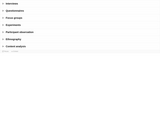
Focus Groups and Questionnaires
- Subject:
- Career and Technical Education
- Criminal Justice
- Material Type:
- Interactive
- Provider:
- Michigan Virtual
- Date Added:
- 07/29/2019

Focus Groups and Questionnaires
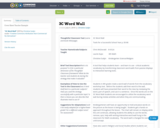
A tool that helps students learn - and learn to use - critical academic vocabulary by transforming classroom word walls from passive displays to interactive learning tools.

This unit on weather, climate, and water cycling is broken into four separate lesson sets. In the first two lesson sets, students explain small-scale storms. In the third and fourth lesson sets, students explain mesoscale weather systems and climate-level patterns of precipitation. Each of these two parts of the unit is grounded in a different anchoring phenomenon.
The unit starts out with anchoring students in the exploration of a series of videos of hailstorms from different locations across the country at different times of the year. The videos show that pieces of ice of different sizes (some very large) are falling out of the sky, sometimes accompanied by rain and wind gusts, all on days when the temperature of the air outside remained above freezing for the entire day. These cases spark questions and ideas for investigations, such as investigating how ice can be falling from the sky on a warm day, how clouds form, why some clouds produce storms with large amounts of precipitation and others don’t, and how all that water gets into the air in the first place.
The second half of the unit is anchored in the exploration of a weather report of a winter storm that affected large portions of the midwestern United States. The maps, transcripts, and video that students analyze show them that the storm was forecasted to produce large amounts of snow and ice accumulation in large portions of the northeastern part of the country within the next day. This case sparks questions and ideas for investigations around trying to figure out what could be causing such a large-scale storm and why it would end up affecting a different part of the country a day later.
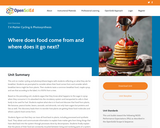
This unit on matter cycling and photosynthesis begins with students reflecting on what they ate for breakfast. Students are prompted to consider where their food comes from and consider which breakfast items might be from plants. Then students taste a common breakfast food, maple syrup, and see that according to the label, it is 100% from a tree.
Based on the preceding unit, students argue that they know what happens to the sugar in syrup when they consume it. It is absorbed into the circulatory system and transported to cells in their body to be used for fuel. Students explore what else is in food and discover that food from plants, like bananas, peanut butter, beans, avocado, and almonds, not only have sugars but proteins and fats as well. This discovery leads them to wonder how plants are getting these food molecules and where a plant’s food comes from.
Students figure out that they can trace all food back to plants, including processed and synthetic food. They obtain and communicate information to explain how matter gets from living things that have died back into the system through processes done by decomposers. Students finally explain that the pieces of their food are constantly recycled between living and nonliving parts of a system.

In this unit, students develop ideas related to how sounds are produced, how they travel through media, and how they affect objects at a distance. Their investigations are motivated by trying to account for a perplexing anchoring phenomenon — a truck is playing loud music in a parking lot and the windows of a building across the parking lot visibly shake in response to the music.
They make observations of sound sources to revisit the K–5 idea that objects vibrate when they make sounds. They figure out that patterns of differences in those vibrations are tied to differences in characteristics of the sounds being made. They gather data on how objects vibrate when making different sounds to characterize how a vibrating object’s motion is tied to the loudness and pitch of the sounds they make. Students also conduct experiments to support the idea that sound needs matter to travel through, and they will use models and simulations to explain how sound travels through matter at the particle level.
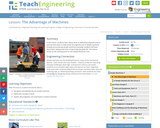
In this lesson, students learn about work as defined by physical science and see that work is made easier through the use of simple machines. Already encountering simple machines everyday, students will be alerted to their widespread uses in everyday life. This lesson serves as the starting point for the Simple Machines Unit.

In this activity about light and perception, learners discover how a flash of light can create a lingering image called an "afterimage" on the retina of the eye. Learners will be surprised when they continue to see an image of a bright object after staring at it and looking away. Use this activity to introduce learners to principles of optics and perception as well as to explain why the full moon often appears larger when it is on the horizon than when it is overhead. This lesson guide also includes a few extensions like how to take "afterimage photographs."
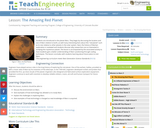
The purpose of this lesson is to introduce students to the planet Mars. This lesson will begin by discussing the location and size of Mars relative to Earth, as well as introduce many interesting facts about this red planet. Next, the history of Martian exploration is reviewed and students discover why scientists are so interested in studying this mysterious planet. The lesson concludes with students learning about future plans to visit Mars.
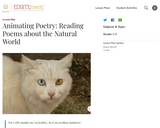
The purpose of this project is two-fold: first, to encourage students to make the reading of poetry a creative act; and, second, to help students appreciate particular literary devices in their functions as semaphores or interpretive signals. Those devices that are about the imagery of a poem (metaphor, simile, personification, description) can be thought of as magnifying glasses: we see most clearly that upon which the poet focuses our gaze. Similarly, those poetic devices that are about the sound of the poem (alliteration, consonance, enjambment, onomatopoeia, and repetition) can be thought of as volume buttons or amplifiers: we hear most clearly what the poet makes us listen to most attentively.
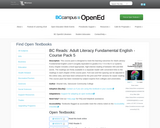
This course pack is designed to meet the learning outcomes for Adult Literacy Fundamental English Level 5 (roughly equivalent to grades 6 to 7.5 in the K-12 system). Every chapter includes a level-appropriate, high-interest reading of between 500 and 800 words. The readings are freely available in a separate reader with convenient links to the readings in each chapter of this course pack. Font size and line spacing can be adjusted in the online view, and have been enhanced for the print and PDF versions for easier reading. This course pack has been reviewed by subject experts from colleges and universities.
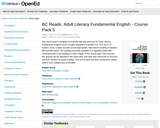
This course pack is designed to meet the learning outcomes for Adult Literacy Fundamental English Level 5 (roughly equivalent to grades 6 to 7.5 in the K-12 system). Every chapter includes a level-appropriate, high-interest reading of between 500 and 800 words. The readings are freely available in a separate reader with convenient links to the readings in each chapter of this course pack. Font size and line spacing can be adjusted in the online view, and have been enhanced for the print and PDF versions for easier reading. This course pack has been reviewed by subject experts from colleges and universities.
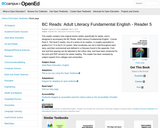
This reader contains nine original stories written specifically for adults, and is designed to accompany the BC Reads: Adult Literacy Fundamental English - Course Pack 5. This level 5 reader, one of a series of six readers, is roughly equivalent to grades 6 to 7.5 in the K-12 system. New vocabulary are set in bold throughout each story, and then summarized and defined in a Glossary found in the appendix. Font size and line spacing can be adjusted in the online view, and have been enhanced for the print and PDF versions for easier reading. This reader has been reviewed by subject experts from colleges and universities.
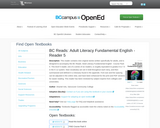
This reader contains nine original stories written specifically for adults, and is designed to accompany the BC Reads: Adult Literacy Fundamental English - Course Pack 5. This level 5 reader, one of a series of six readers, is roughly equivalent to grades 6 to 7.5 in the K-12 system. New vocabulary are set in bold throughout each story, and then summarized and defined in a Glossary found in the appendix. Font size and line spacing can be adjusted in the online view, and have been enhanced for the print and PDF versions for easier reading. This reader has been reviewed by subject experts from colleges and universities.
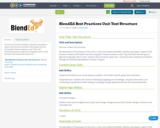
In this unit students will define, identify, and explain 5 types of text structure. Students will explain how text and graphic features enhance a text. They will determine the type of figurative language used in a text. Students will summarize a given text.
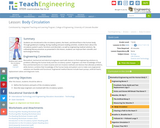
Students are introduced to the circulatory system, the heart, and blood flow in the human body. Through guided pre-reading, during-reading and post-reading activities, students learn about the circulatory system's parts, functions and disorders, as well as engineering medical solutions. By cultivating literacy practices as presented in this lesson, students can improve their scientific and technological literacy.
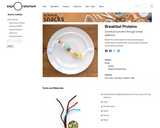
Construct a protein through cereal additions. Model the central dogma of molecular biology by constructing a colorful chain using a simple code (and some delicious cereal).
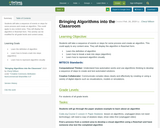
Students will take a sequence of events or steps for some process and create an algorithm. This could apply to any content area. They will display the algorithm in flowchart form. This activity can be modified for all grade levels and content areas.
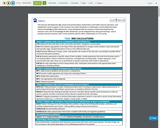
This task was developed by high school and postsecondary mathematics and health sciences educators, and validated by content experts in the Common Core State Standards in mathematics and the National Career Clusters Knowledge & Skills Statements. It was developed with the purpose of demonstrating how the Common Core and CTE Knowledge & Skills Statements can be integrated into classroom learning - and to provide classroom teachers with a truly authentic task for either mathematics or CTE courses.
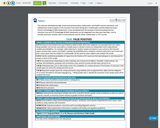
This task was developed by high school and postsecondary mathematics and health sciences educators, and validated by content experts in the Common Core State Standards in mathematics and the National Career Clusters Knowledge & Skills Statements. It was developed with the purpose of demonstrating how the Common Core and CTE Knowledge & Skills Statements can be integrated into classroom learning - and to provide classroom teachers with a truly authentic task for either mathematics or CTE courses.

This task was developed by high school and postsecondary mathematics and health sciences educators, and validated by content experts in the Common Core State Standards in mathematics and the National Career Clusters Knowledge & Skills Statements. It was developed with the purpose of demonstrating how the Common Core and CTE Knowledge & Skills Statements can be integrated into classroom learning - and to provide classroom teachers with a truly authentic task for either mathematics or CTE courses.